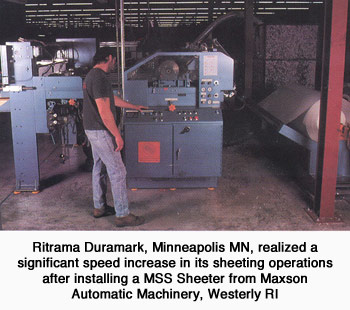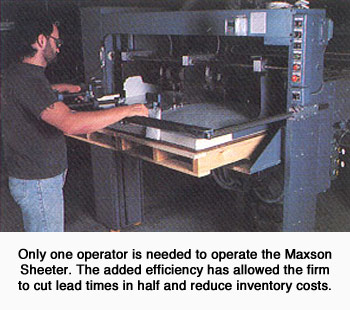A Midwest converter’s commitment to service and quality through upgrading and improving operations has helped the firm achieve an average 60% annual growth rate during the past eight years.
Universal Duramark, Minneapolis, MN, has supplied the graphic-arts industry with pressure-sensitive-film products since 1962. As demand for these products grew, so did the company’s operations. In 1988, it acquired Duramark Films, Cleveland, OH. In October 1990, Universal Duramark was acquired by Ritrama, Milan, Italy, and is now know as Ritrama Duramark.
 The converter’s success is based on its commitment to service and quality. The desire to improve and upgrade the operations whenever possible has led to its healthy growth rate.
The converter’s success is based on its commitment to service and quality. The desire to improve and upgrade the operations whenever possible has led to its healthy growth rate.
Sheet fed products have led the growth in the graphics-arts-products industry, which placed a strain on Ritrama Duramark’s sheeting operations. While sheeting has always been a part of the firm’s manufacturing processes, its sheeting equipment couldn’t keep up with demand.
“We needed to increase the production of our sheeting operation as well as sheet more efficiently,” Daryl Hanzal, general manager of Ritrama Duramark’s Minneapolis facility, said “On our two older sheeters, we had to restack the sheets after sheeting and setup was time consuming.”
After investigating the sheeting equipment available, the firm selected an MSS sheeter from Maxson Automatic Machinery, Westerly, RI.
“The Maxson offered us greater speed and ease of operation,” Hanzal said “The stacking was automated and required less operator attention.”
At Ritrama Duramark, the sheeter operates at speeds up to 250 fpm. This represents a significant speed increase over the company’s earlier equipment.
“With the MSS sheeter we can sheet 1.5 times faster than on the older equipment,” he said. “This means that during an eight-hour shift, we can produce 150,000 sheets on the Maxson versus 100,000 sheets previously.”

The ability to produce more sheets during a shift has allowed the company to cut lead times in half. Turnaround times for sheeted stock have gone from six days to three days. The added capacity has also reduced inventory costs because the company doesn’t have to maintain a large inventory of sheets in stock.
In addition to production gains, the company’s labor costs have dropped. One operator is needed to run the new sheeter compared with two operator required to operate the older machine. The machine’s efficiency is a result of its design. Maxson designed the sheeter to minimize the static buildup that makes film difficult to sheet. Air is used at the stacker to help float the sheets out over the pile. The machine’s jogging system stacks the sheets without the need to restack the material after it’s sheeted.
A shaft-type unwind stand with edge guidance was selected because many of the rolls sheeted at the facility are telescoped. The edge-guidance system aligns the web as it feeds into cutter. Without this feature, the sheeter operator must take an edge trim when slitting telescoped rolls.
“If we didn’t have edge guidance, our operator would have to run the sheeter at half speed to have enough time to adjust the brakes manually,” Hanzal said.
The addition of the MSS sheeter has fit well with the company’s plans for future expansion. “In a mature industry like ours, service is very important,” he said. “The sheeter beefs up the service aspect of our business. We have enough capacity to support our growth rate while giving our customers the quality they expect.”
Reprinted from Paper Film Foil Converter, March 1991






